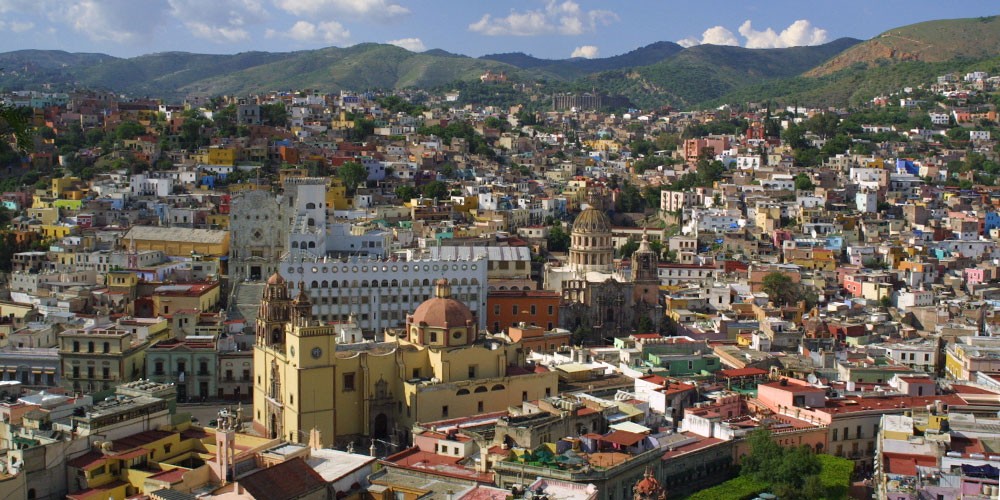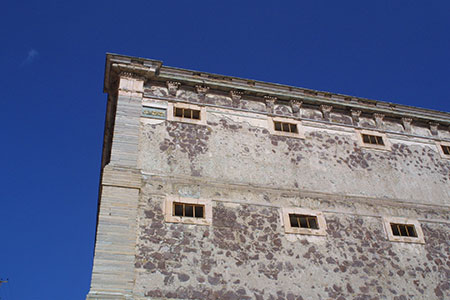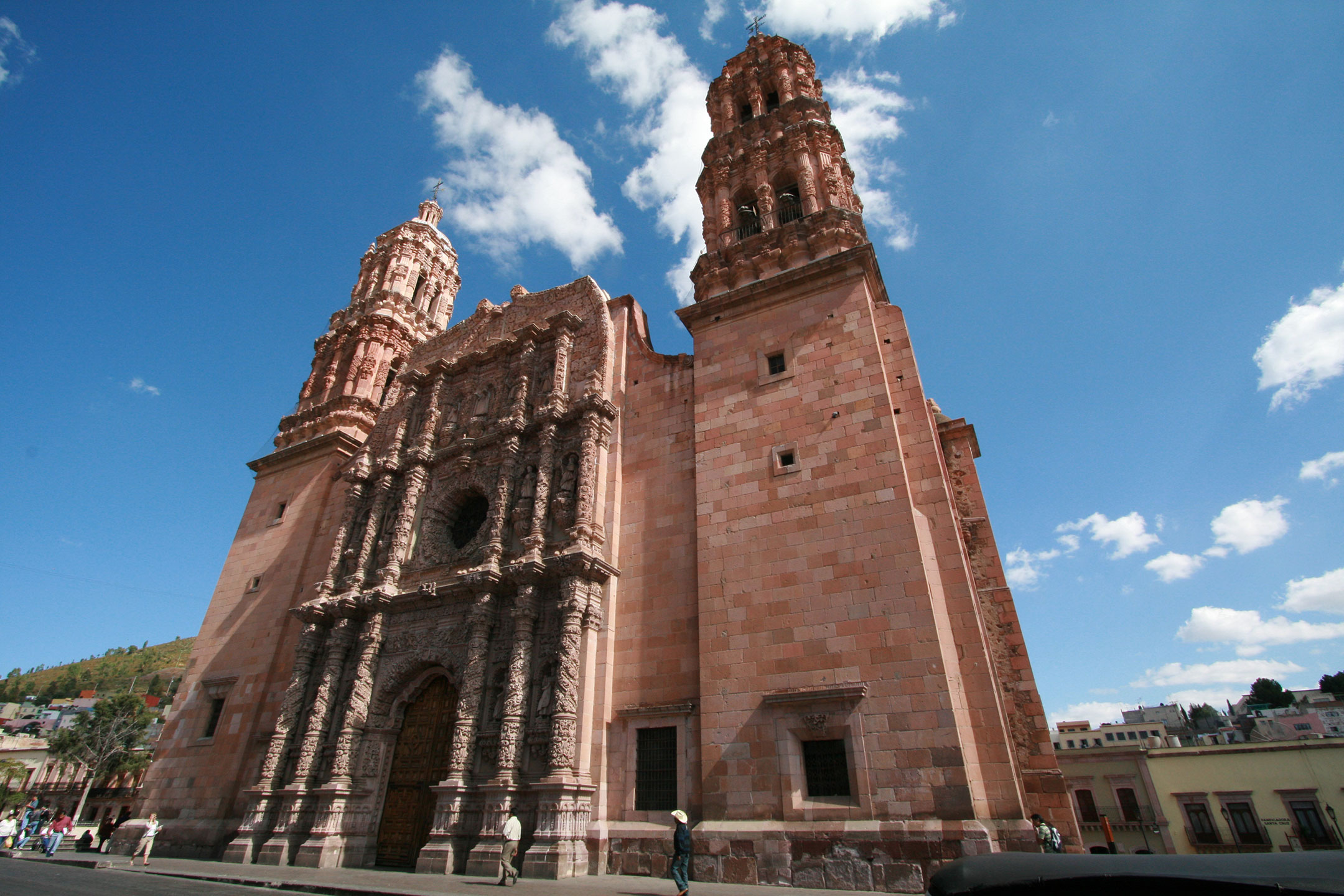Lively Guanajuato is a colonial city that owes its prosperity to the gold and silver mines of the area. Opulent mansions line the main roads curving through the gorge in which it lies, whilst simpler but colorful dwellings sit almost one upon the other on the hillsides.
The whole city buzzes with activity from the university students and the influx of visitors, especially around the time of one of the city’s many festivals. In October the world focus is upon Guanajuato as the International Cervantino Festival brings many famous names in the areas of dance, theater and music to the city.
To appreciate the atmosphere of the city, chose a hotel in the center of town and stroll the streets at leisure. Be sure to pause for a while in the many small plazas to watch the activity over a meal or a drink. The early evening is the time when young and old alike take to the streets and the air is filled with music from impromptu concerts and wandering entertainers.
You might notice the absence of heavy traffic in the narrow streets; this is because many vehicles are routed through the system of underground tunnels beneath the city. This is not a modern solution; many years ago the river passed through these passages and, after many years of routine flooding, was diverted away from the town. The old river bed then became an ideal subterranean highway. Today many houses have balconies suspended above these strange, winding roads.
Jardin de la Union. Jardin de la Union is the heart of Guanajuato, the city’s designated meeting place and entertainment center. The plaza is triangular in shape and is almost filled with a hedge of Indian laurels, in the middle is a bandstand and a fountain. Benches line the walkways around the plaza, most are occupied at any given time by couples engaged in conversation, teenagers in groups, elderly ladies resting awhile and tourists consulting their guidebooks.
Teatro Juarez. This magnificent theater is the setting for many of the productions of the Cervantino Festival. It was completed in 1903 and its exuberance is typical of the era. President Porfirio Diaz attended the inaugural production of the opera “Aida”, reported to be a lavish occasion.
El Pipila. Looking out over the city, this massive statue is a reminder of Guanajuato’s turbulent history. During the first stages of the War of Independence, after Hidalgo made his famous ‘grito’ or declaration at nearby Dolores (now Dolores Hidalgo), his rebel troops attempted to take Guanajuato. During the struggle the Royalists took shelter in the Alhondiga and would probably have been able to hold out, had not Jose de los Reyes Martinez – known as El Pipila – set fire to its doors. The royalists were slaughtered as they tried to escape, and El Pipila was also killed, but the Hidalgo’s troops took control (briefly) of the city.
A steep series of steps leads up from the Callejon del Beso to the top of the hill and the Pipila statue (the walk is signed “al Pipila”). It’s a very energetic climb, but the views are amazing. For an easier route to the top, use the funicular next to the Teatro Juarez.
Alhondiga de Granaditas. The Alhondiga de Granaditas was built at the end of the 18th century as a storage house for grain. Its history took a dramatic turn when it was the scene of a massacre at the start of the War of Independence as Miguel Hidalgo attempted to seize the city in 1810. Many Spanish troops and supporters took refuge in the Alhondiga with their families, but were forced out when El Pipila set fire to the doors. Hundreds were killed in the ensuing panic, and the rebels claimed a victory. Their celebrations were short-lived as the Royalists regained the city – Hidalgo and three of his leaders were executed and their heads were hung in cages on the four corners of the building. The long hooks where the cages hung for ten years are still visible. Nowadays the Alhondiga is a museum, open Tuesday to Saturday from 9:00am to 2:00pm and 4:00pm to 6:00pm, Sundays 10:00am to 2:30pm.
Plaza de la Paz. Plaza de la Paz is another triangular plaza, dominated by the Basilica de Nuestra Senora de Guanajuato and bordered by Avenida Juarez to the west. Magnificent mansions built by wealthy mine owners surround the fountain and small gardens. Today there are several cafes spilling out onto the pedestrianised section of the road, popular at all hours of the day.
Basilica de Nuestra Senora. Towering over the Plaza de la Paz, the Basilica de Nuestra Senora de Guanajuato has a fairly plain, yellow painted facade, asymmetrical with its single clock tower. It houses a venerated carving of the Our Lady of Guanajuato, patroness of the city, allegedly sent by King Philip II of Spain in 1557. The image was already centuries old when it was delivered, and is believed to be one of the oldest of its kind in Latin America.
Plaza de Los Angeles. The Plaza de los Angeles lies below a maze of “callejones” or alleyways winding up the hillside to El Pipila. One of these is signed from the plaza (or rather its name is painted on a wall with an arrow pointing the way) – Callejon del Beso, or Alley of the Kiss. It was so named because the alley is so narrow that two of the houses on opposite sides have balconies close enough together to allow the inhabitants to kiss. You can usually find the way by following the numerous tour groups that crowd into the tiny passageway.
Plaza San Roque. Plaza San Roque is a pretty square famous for the scene of the production of “entremeses” by the student population. These short dramas, complete with theatrical costumes that are in complete harmony with the majestic surroundings, were intended to be performed in the intervals between performances at the Cervantino Festival, hence their name. During the University term, candlelit performances are often given on Sundays around 8:00pm. It is well worth trying to get a seat for these atmospheric productions.
The city is incredibly busy during the Cervantino Festival, which usually falls in October. if you want to see the fiesta, book well in advance. If you are not interested in the entertainment we recommend visiting at another time of year as the crowds can spoil your enjoyment of the city.
La Valenciana. At the height of Guanajuato’s success, the mine ‘La Valenciana’ was producing over one quarter of the world’s silver. It lies around 5km from the town center and is open to visitors, though it is not possible to go down the mine shaft. Many of Guanajuato’s most splendid churches were built from the riches of the mine owners, but the most impressive of all is the church of La Valenciana, opposite the mine. The amazingly ornate, churrigueresque style facade is one of Mexico’s finest and the gilded interior is appropriately lavish.











